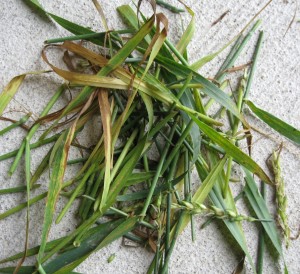I had the fortune of speaking with specialists at the University of Delaware (Galen Dively and Joanne Whalen) yesterday and learned more about these grass sawflies. Delaware finds them in many of their fields every year and scouts early each season to see if they are going to be a problem. Here is what I’ve learned from that conversation:
1. It was the abnormally warm April weather that we experienced that helped promote the sawfly problem. The very warm spring favoured egg laying.
2. The feeding activity usually only lasts for about two weeks at most.
3. There are 6 instars. The last instar being over an inch long.
4. They are usually found in clumps in the field, with higher numbers near the edge of the field. One larvae can clip approx 10-12 heads.
5. They recommend using the highest rate registered to control them as they are tougher than armyworm to control.
6. They use the threshold of : a) 0.4 larvae per linear foot of row or b) 0.7 larvae per square foot of surface area. It is too late to treat if the number of clipped heads per unit area is 3 to 4 times the average worm count and most caterpillars are greater than 1 inch long. If there is a combination of armyworm and sawflies, they lower the threshold.
However, as mentioned before, we feel that here in Ontario, if you are seeing 30 heads clipped per square meter or 3 per square foot, AND the larvae are present in the field, the cost of control may be worth it. Counting larvae for some has been difficult but finding clipped heads has not been. YOU MUST follow days to harvest intervals though. Matador is no longer an option since its days to harvest is 28 days. Lannate has a days to harvest interval of 20 days, Dylox is 21 days to harvest and Sevin is 14 days to harvest.
As the crop matures, the larvae will be less likely to feed. It appears that they like to clip the stems to suck the juice from the plant. As the stem starts to dry, the less likely they will want to clip. They have started to clip more of the stems than just at the base of the head. Leanne Frietag of Cargill provided me with this picture of damage that she found. As you can see, the sawflies have cut 4 to 5 inch sections along the stem of the plant.

After speaking with Delaware, I am reassured that the end is near. We are probably looking at only another week or less of feeding. And now we know that if we get another warm April, we had better sweep the wheat fields in May and early June to see if sawfly larvae are present so that we can deal with them prior to this clipping.
This spring is already teaching us something new 🙂 Never a dull moment in the bug world.